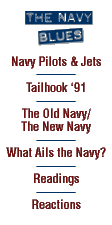
|


At the time of Tailhook, Kelso was Chief of Naval Operations and also
attended the convention. He joined in the public and Congressional outrage
and implemented measures to end sexual harassment of women in the Navy and
offer them opportuity to serve as combat aviators. His career was
short-circuited by Tailhook and he took early retirement in April 1994.
Q: Your assessment of where the Navy is in the Persian Gulf War? You're
right there, watching that. What's happening with the Navy?
KELSO: In many ways, it was a war that was not a naval battle. It was a war
that was going to take place primarily on land and in the air, and we could
support the air side, but there weren't too many navies to have to take. The
one thing people tend to forget is that there was not one ship or one method of
supply that was touched by anybody during that war. So that's the Navy's role,
is to make sure that provisions get to the Army and to the Air Force during the
war. That clearly took place. I think we learned that we had to do more in
the future to make the battlefield seamless between sea, air, and land, for the
Navy. And we had to increase and improve our communications to do that. And I
think we've done that today. Since the war, we've added that capability that
we needed more of during the war.
The world had changed. The Cold War was over. We had to adopt our tactics
and what our role was going to be in that war. It hadn't changed the idea that
we had to deliver the heavy material, because most all of it goes by sea, and
protect it no matter where we might be engaged again. But for the day, the
idea that we were going to be supportive in the tactics of the battle with our
friends in the Air Force and the Army, we had to change the way we looked at
things. We had to change the kind of munitions we bought in the air, for
example, to buy more precision guided missiles, to have more of them available
to do the job. So we learned a lot from the war. We had to do more in the
ability to keep mines from being a problem and to sweep them once they were a
problem. So that changed the way we spent our money after the war. And I
think we're doing that successfully.
Q: Were you happy with what had happened, how the Navy had executed its
mission in the Persian Gulf War?
KELSO: Absolutely.
Q: The role of aviation?
KELSO: Yeah. I think they did extremely well with the tools that they had, and
did a very fine job.
Q: I've heard from other aviators that there was a sense of
unhappiness at the end of the war--this wasn't their unhappiness with the Navy.
This was their unhappiness with the way things worked out, that here was one
aging weapon system or airplane was going out of business at the end of this
war; that they hadn't gotten in as many--
KELSO: That decision had not been made at the end of the war. It was made well
beyond, subsequent to that.
Q: But there was unease. These guys were saying, "Hey, is this really
going to happen? Is this going to go away? Gee, we didn't get to fly as much
as we really wanted to fly over there....it looks like the Air Force got a lot
of headlines...it looks like women are going to jump into combat roles. " They
had a list of grievances coming out of that war. Your reaction?
KELSO: Well, there's no doubt, if you talked to them, some of them felt that way.
It was clear that the funding for defense was going to change. The Cold War
was over, and we were not going to spend the kind of bucks we had in the past
for military hardware. And so the Navy, like all the other services, was going
to have to adjust to the times in which we live. We did subsequently make a
decision to put the A-6 out of business. We had hoped for a replacement of the
A-6 with the A-12, which was lost. We had to reduce the number of airplanes
the Navy had, just like we had to reduce the number of ships. If you were
going to reduce an airplane, the age of that airplane clearly made it the
airplane to reduce. And that was the decision that the Navy made.
Now, that decision was not made by guys who don't fly airplanes. They have
certainly had an input into how we were going to reduce the funding we spent.
I remember one young pilot (well, he was a captain at the time) came back from
that war, and he said, "You know, Admiral, we should never buy anything but a
dual purpose airplane again." Some of them felt strongly that we needed to
have an airplane that could be either a fighter when necessary, or it could go
air-to-ground when necessary. And the F/A-18 was that airplane that we were
buying at the time. So we made a decision to go with more F/A18's and let the
A-6 go out of the inventory. We wanted to reduce the number of airplanes that
the Navy had in total, because it's expensive to maintain lots of types of
airplanes. We wanted to build what we considered was the new F/A-18... Where
do we find the money to do that? So you have to make some decision like
that.
Those who rode in the back seat were worried about their jobs during this
period of time. If you bought a new F/A18 type airplane, would it have two
people in it or one person in it? It created a great deal of anxiety in that
area. There's no question that there was an anxiety ... females going to be
taken into combat. We made that decision. I think that was the right decision
to make. It was not a decision that was acclaimed by all as the right thing to
do. The world passes on, and we do things differently. And so those anxieties
were there. As you make change, people have to learn to live with the change.
And so I'm not surprised that those anxieties might have been there. There
were reasons for the anxieties, and we're continuing to live with
change.
Q: Tough to downsize a great big outfit like the Navy?
KELSO: Yes, it is difficult to downsize a great big outfit like the Navy,
because the toughest part is to downsize the people. We took almost
200,000 people out of the Navy. It went around 400,000, plus a lot out of the
civilian side. You can't do it without making a lot of them unhappy.
Fortunately, the Congress was generous in giving us ways for them to leave
without leaving either a lump sum or a small pension if they left the Navy
during that period of time. And I think in the Navy we were able to not push
anybody out that we didn't retire or provide one of the benefits that the
Congress gave them during that period of time, which I felt was very necessary
that we do that now. But we had to select people out that were very capable,
particularly in the senior officer ranks, like captains, which was very, very
difficult to do. It's not much fun to go from almost a 600-ship Navy to a
330-ship Navy. It's tough to think about the young officer who's on a ship
that's been decommissioned, or the young petty officer on a ship that's being
decommissioned. He didn't plan on that, and how he's got to move. Maybe he's
got to move across country, pick his family up, and do all that sort of thing.
It was necessary, but not much fun to do. It's a difficult period of time.
Q: What do you figure it does to the psychology of the Navy, to have this
kind of a big shock ?
KELSO: I'm not sure that anybody can answer that yet. From my standpoint and my
belief is at this point in time that people in the Navy said, "Okay, this is
the way our country has told us to do," and they picked up the ball. I can't
remember an deployments we've missed. You went out to sea on one of our
carriers, they were operating pretty well. That carrier was overhauled during
this period of time. One of the finest overhauls any carrier's ever done,
because we had great, great people on it, that made that take place. If you
look at the Navy inside the Beltway, you always get one view. It's kind of
like reading the Post or the one in my hometown. You'd think you were
in different countries. It's kind of the same way here. And Navy people are
resilient. They do terrific jobs. And I think they've carried this downsizing
off in an amazing way.
continued
|